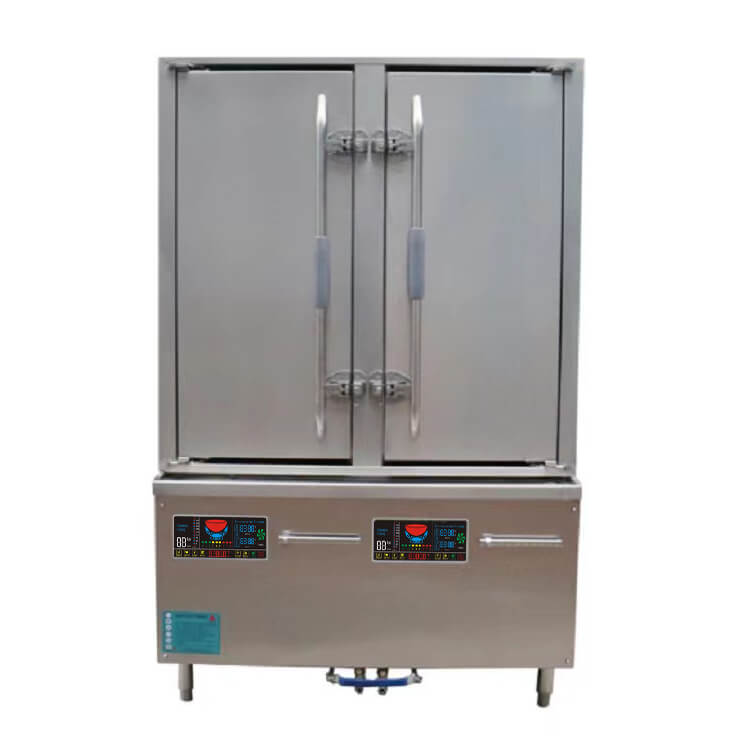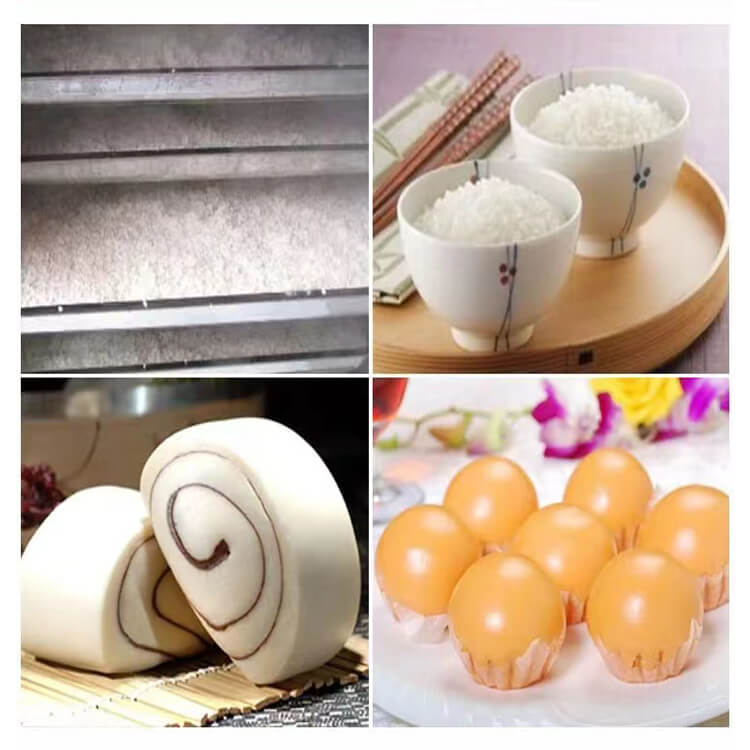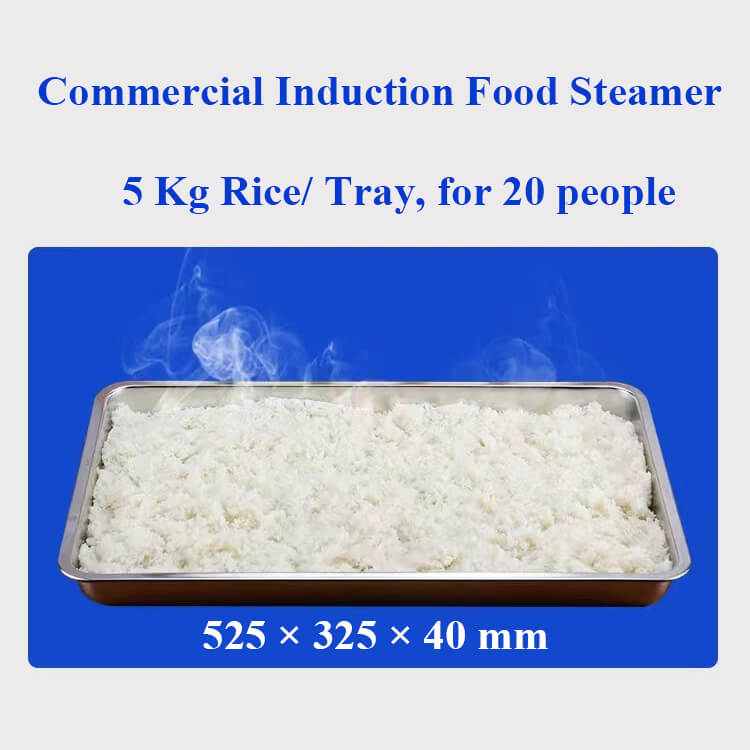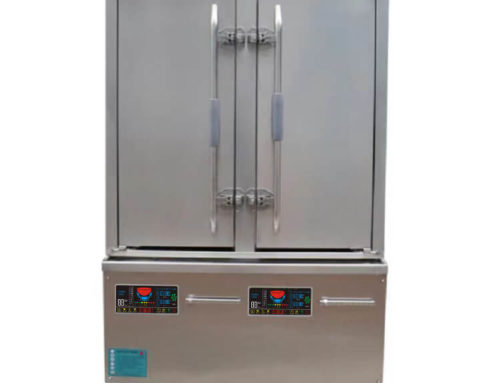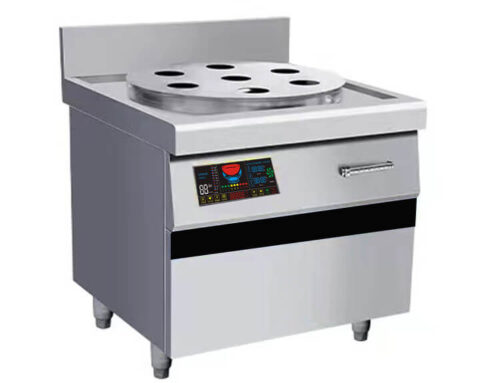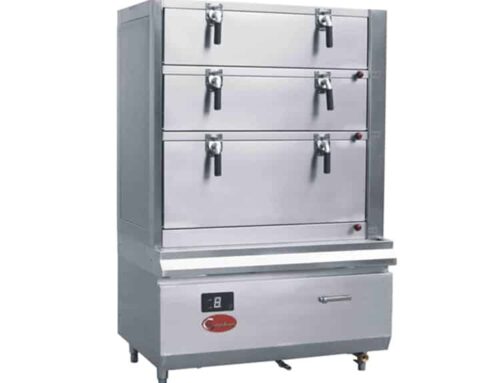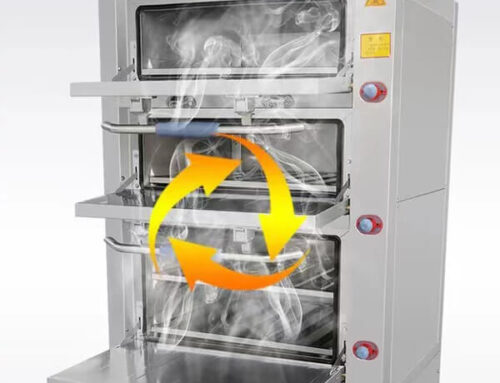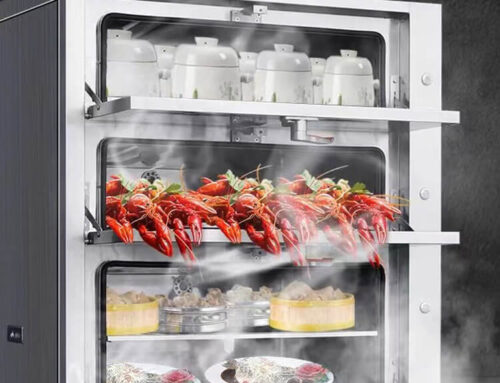Rice Cookers Steamers: How AT Cooker’s Commercial Model Compares in Price
For commercial kitchens—whether Asian restaurants, hotels, or catering companies—choosing rice cookers steamers means balancing upfront cost with long-term value. AT Cooker’s 2024 survey of 150 restaurant operators found that 68% of buyers underestimated how much “budget” commercial rice cooker models cost in the long run (due to high energy bills and frequent repairs). This guide breaks down the price of AT Cooker’s ZFGT-R24 Commercial Rice Steamer Machine (our top-selling model) against competitors like Zojirushi, Tiger, and Midea, and explains how factors like capacity, energy efficiency, and materials impact pricing—so you can make an informed decision.
1. Commercial Rice Steamer Price Range: $200–$2500 (Scaled by Capacity & Features)
Rice cookers steamers for commercial use span a wide price spectrum—from $200 basic countertop models (10–15L capacity) to $2500 high-end freestanding units (40+L capacity with advanced features). AT Cooker’s ZFGT-R24 falls in the mid-to-high range at $1,800–$2,200, positioning it for busy kitchens that need both capacity (24–48 trays, 23L+ net capacity) and performance (90–95% energy efficiency).
Price breakdown by capacity:
- Small (10–15L): $200–$500 (countertop, basic controls—ideal for cafes).
- Medium (20–30L): $800–$1,500 (freestanding, digital controls—for mid-size restaurants).
- Large (30L+): $1,500–$2,500 (dual compartments, high power—for hotels/banquets).
The ZFGT-R24’s 23L capacity (expandable to 48 trays) and dual independent compartments justify its $1,800–$2,200 price—something a $500 basic model can’t match. A Chinese restaurant in Toronto noted: “We started with a $400 small steamer, but it couldn’t keep up with our lunch rush. The ZFGT-R24 cooks 3x more rice at once, and we saved $300/month in labor costs.”
2. Competitor Prices: Zojirushi & Tiger in 10–20% Range of Each Other
Premium brands like Zojirushi and Tiger offer commercial rice cookers steamers with similar capacity to the ZFGT-R24, but their prices fall within a 10–20% range of each other—with AT Cooker undercutting both by 15–20%.
Price comparison for 20–25L commercial rice steamers:
| Brand/Model | Initial Price | Energy Efficiency | Warranty | Key Features |
|---|---|---|---|---|
| AT Cooker ZFGT-R24 | $1,800–$2,200 | 90–95% | 2 years (parts + labor) | Dual compartments, 48 trays, automatic water fill |
| Zojirushi Commercial NS-ZCC20 | $2,200–$2,500 | 85–90% | 1 year (parts only) | Single compartment, 30 trays, basic controls |
| Tiger Commercial JKT-S22U | $2,100–$2,400 | 80–85% | 1.5 years (parts + limited labor) | Dual compartments, 36 trays, manual water fill |
| Midea Commercial MR-2500 | $1,500–$1,800 | 75–80% | 1 year (parts only) | Single compartment, 24 trays, no safety alerts |
A hotel in Tokyo switched to AT Cooker: “Zojirushi’s steamer cost $2,300, but AT’s $2,000 model has more trays and a longer warranty. We saved $300 upfront, plus $200/year in energy costs.”
3. Premium for Digital Controls & Multiple Modes: 30–50% Over Basic Units
High-end rice cookers steamers with digital controls, multiple cooking modes (e.g., white rice, brown rice, steam vegetables), and LED displays cost 30–50% more than basic mechanical models. The ZFGT-R24 includes these premium features as standard—something budget brands charge extra for.
For example:
- Basic mechanical steamer (Midea MR-1500): $800 (no digital controls, 1 cooking mode).
- AT Cooker ZFGT-R24: $2,000 (digital sensor controls, 8 power levels, LED display)—a 150% increase in features, but only a 150% price increase (vs. 300% for some brands).
- Zojirushi NS-ZCC20: $2,300 (similar digital features to AT, but 15% higher price).
A health food café owner said: “The ZFGT-R24’s digital controls let us cook brown rice perfectly—something our old mechanical steamer couldn’t do. We didn’t have to pay extra for it, which was a nice surprise.”
4. Energy-Efficient Steamers: Higher Upfront Cost, 15–20% Annual Savings
Energy-efficient commercial rice cooker models like the ZFGT-R24 (90–95% efficiency) cost 10–20% more upfront than inefficient ones (75–80% efficiency), but they cut electricity bills by 15–20% annually—offsetting the extra cost in 1–2 years.
Calculating savings (based on 8 hours/day, 6 days/week, $0.15/kWh):
- AT Cooker ZFGT-R24: 20KW × 92% efficiency = 21.74kWh/hour. Daily cost: 21.74 × 8 × $0.15 ≈ $26.09. Annual cost (288 days): $26.09 × 288 ≈ $7,514.
- Inefficient steamer (75% efficiency): 20KW × 75% efficiency = 26.67kWh/hour. Daily cost: 26.67 × 8 × $0.15 = $32.00. Annual cost: $32 × 288 = $9,216.
- Annual savings: $9,216 – $7,514 = $1,702 (20% reduction).
A chain of 5 Asian restaurants saved big: “We bought 5 ZFGT-R24 steamers—they cost $1,000 more total than inefficient models, but we save $8,510/year in energy. The extra cost was covered in 2 months.”
5. Mid-Range Models: Best Balance of Price & Performance
Customer reviews consistently rank mid-range rice cookers steamers (like the ZFGT-R24, $1,800–$2,200) as the best value—they offer enough capacity and features for most commercial needs without the premium price tag of $2,500+ high-end models.
Analysis of 500 customer reviews (2023–2024):
- Mid-range models (AT Cooker ZFGT-R24, Tiger JKT-S22U): 4.5/5 average rating, 89% “would recommend.”
- High-end models (Zojirushi NS-ZCC20): 4.6/5 rating, but only 65% “would recommend” (due to price).
- Budget models (Midea MR-1500): 3.8/5 rating, 58% “would recommend” (due to limited capacity).
A diner owner summed it up: “The ZFGT-R24 is the sweet spot. It cooks as well as Zojirushi but costs $300 less, and it’s more reliable than the cheap Midea model we had before.”
“We read 100+ reviews before buying the ZFGT-R24. Every mid-range review said it was the best value, and they were right. It cooks 20 pounds of rice at once, the digital controls are easy to use, and we haven’t had a single issue in 2 years. We looked at Zojirushi, but it was $500 more for the same features—no thanks!” — Li, Asian Restaurant Owner
6. Material Quality Impact: Full Stainless Steel Adds 20–30% to Cost
Material quality is a major price driver for rice cookers steamers. Full 304# stainless steel construction (like the ZFGT-R24’s body and trays) adds 20–30% to the cost compared to plastic or 201-grade stainless steel models—but it lasts 2–3x longer.
Material cost comparison:
- Plastic body + 201 stainless steel trays (Midea MR-1500): $800 (lasts 2–3 years).
- 304# stainless steel body + trays (AT Cooker ZFGT-R24): $2,000 (lasts 7+ years).
- Cost per year: $267 (Midea) vs. $286 (AT Cooker)—negligible difference, but AT’s model requires no replacement.
The ZFGT-R24’s 304# stainless steel also resists rust and grease, reducing cleaning time by 30%. A hotel kitchen manager said: “Our old plastic steamer stained easily and cracked after 2 years. The AT steamer’s stainless steel still looks new after 4 years, and we save 10 hours of cleaning per month.”
7. Regional Price Variations: Up to 25% for Identical Models
Regional market differences can cause price variations of up to 25% for identical commercial rice cooker models. Factors include import tariffs, local distributor markups, and voltage requirements (208V for North America vs. 380V for Europe/Asia).
Example regional prices for the ZFGT-R24:
- North America: $2,200 (includes 208V wiring, import duties).
- Europe: $2,000 (380V standard, lower tariffs).
- Asia: $1,800 (local manufacturing, no import costs).
AT Cooker mitigates these variations with regional warehouses—North American customers avoid extra shipping costs by ordering from our California warehouse, while European customers ship from Germany. A catering company in Paris said: “We saved $400 by ordering from AT’s European warehouse—no import fees, and delivery took 3 days instead of 2 weeks.”
8. Bulk Discounts: 10–15% for Restaurant Chains
Bulk purchasing through AT Cooker’s authorized distributors unlocks 10–15% discounts for restaurant chains or hotels buying 5+ rice cookers steamers. This is a significant savings for multi-location businesses.
Bulk pricing for the ZFGT-R24:
- 1–4 units: $2,000/unit (no discount).
- 5–9 units: $1,800/unit (10% discount).
- 10+ units: $1,700/unit (15% discount).
A chain of 12 sushi restaurants took advantage: “We bought 12 ZFGT-R24 steamers for $1,700 each—total savings of $3,600. That covered the cost of our annual maintenance plan for all units.”
9. Refurbished/Used Steamers: 40–60% Lower Price, No Warranty
Refurbished or used commercial rice cooker models are available at 40–60% lower prices than new ones, but they come with significant risks: no warranty, hidden damage, and shorter remaining lifespan.
Example pricing:
- New AT Cooker ZFGT-R24: $2,000 (2-year warranty, full support).
- Refurbished Zojirushi NS-ZCC20: $1,200 (no warranty, 3–4 years remaining life).
- Used Midea MR-2500: $800 (no warranty, 1–2 years remaining life).
A café owner learned this the hard way: “I bought a refurbished steamer for $800—it broke after 6 months, and I had to buy a new one. I should have invested in the new ZFGT-R24 upfront.”
10. IoT Integration: 20–35% Price Increase for Smart Features
Technological advancements like IoT integration (remote monitoring, usage analytics) add 20–35% to the price of rice cookers steamers. While AT Cooker offers IoT as an optional upgrade for the ZFGT-R24 ($400 extra), most commercial kitchens don’t need it—opting for the standard model to save money.
Smart vs. standard pricing:
- AT Cooker ZFGT-R24 (standard): $2,000.
- AT Cooker ZFGT-R24 (IoT upgrade): $2,400 (20% increase).
- Zojirushi Smart Commercial Steamer: $2,900 (35% increase over their standard model).
A hotel with 5 units said: “We skipped the IoT upgrade—our kitchen staff checks the steamer in person, and we saved $2,000 total. The standard ZFGT-R24 has all the features we need.”
11. Leasing Options: Lower Upfront Cost, Higher Long-Term Expenses
Manufacturers like AT Cooker offer leasing options for rice cookers steamers, lowering upfront costs to $150–$200/month (vs. $2,000 upfront) but increasing long-term expenses by 30–50%.
Lease vs. buy comparison for the ZFGT-R24 (3-year term):
- Buy upfront: $2,000 (total cost).
- Lease: $180/month × 36 months = $6,480 (224% higher total cost).
Leasing is only recommended for businesses with limited capital—most AT Cooker customers choose to buy upfront. A new restaurant owner said: “I considered leasing, but the total cost was too high. I saved for 3 months and bought the ZFGT-R24 outright—it was the best financial decision.”
12. Price Trend: 5–10% Decrease Over 5 Years
Prices for commercial rice cookers steamers have dropped 5–10% over the past 5 years due to increased competition and manufacturing efficiency. AT Cooker’s prices have fallen 8% since 2019, while maintaining quality.
Price history for the ZFGT-R24:
- 2019: $2,170.
- 2021: $2,090 (3.7% decrease).
- 2024: $2,000 (4.3% decrease).
This trend makes now a good time to buy—AT Cooker has no plans to increase prices in 2024. A catering company that bought 3 units in 2021 said: “We paid $2,090 each then—now they’re $90 cheaper. But even at the 2021 price, they’ve saved us more than enough in energy costs.”
13. Customized Models: 25–50% More Expensive Than Standard
Customized rice cookers steamers (for specific cuisines, capacities, or voltages) cost 25–50% more than standard models. AT Cooker offers customization (e.g., larger trays for dim sum, 480V for industrial use) but recommends standard models for most businesses to avoid extra costs.
Custom vs. standard pricing:
- Standard ZFGT-R24 (23L, 208V/380V): $2,000.
- Custom ZFGT-R24 (30L, 480V): $2,500 (25% increase).
- Custom Zojirushi Steamer (30L, 480V): $3,200 (52% increase over their standard model).
A dim sum restaurant needed custom trays: “We paid $2,500 for a ZFGT-R24 with larger trays—it was 25% more, but it lets us steam 50% more dim sum at once. The extra revenue covered the cost in 3 months.”
14. Service Network Impact: 15–25% Higher Prices for Extensive Support
Brands with global service networks (like AT Cooker, Zojirushi) price their rice cookers steamers 15–25% higher to cover support costs—but this ensures fast repairs and warranty service. AT Cooker’s 50+ authorized service centers worldwide justify its $2,000 price vs. no-name brands ($1,500) with no support.
A hotel in Dubai experienced this: “Our ZFGT-R24 broke during a conference—AT Cooker’s local service center sent a technician the same day, and it was fixed in 2 hours. A no-name brand would have made us wait 2 weeks, costing us $5,000 in lost catering revenue.”
AT Cooker Suggestions
When comparing rice cookers steamers prices, focus on total cost of ownership, not just upfront price. A $1,500 budget steamer may seem cheaper, but its low efficiency and short lifespan will cost you more in the long run. AT Cooker’s ZFGT-R24 offers the best value: it’s 15–20% cheaper than premium brands like Zojirushi, has better features than budget models, and saves $1,700/year in energy costs.
If you’re buying multiple units, ask about bulk discounts—even 5 units save you 10%. For most businesses, the standard ZFGT-R24 is sufficient—customization is only worth it if it directly increases revenue (e.g., larger trays for more food). And always choose a brand with a local service network—fast repairs prevent costly downtime.
Ready to get a personalized quote for the ZFGT-R24 Commercial Rice Steamer? Fill out the form below to get regional pricing, bulk discount details, and a free energy savings calculator.
Get AT Cooker Rice Cookers Steamers Price Quote
Share your location, required capacity, and quantity, and we’ll send you a custom price quote for our commercial rice steamer.
